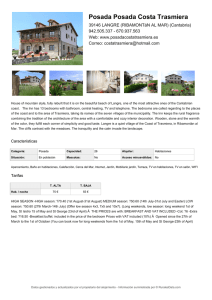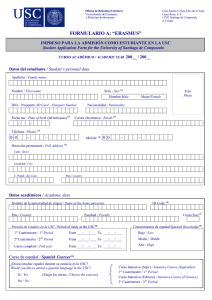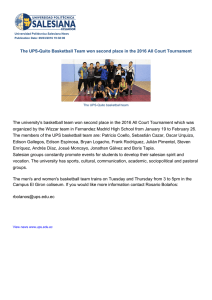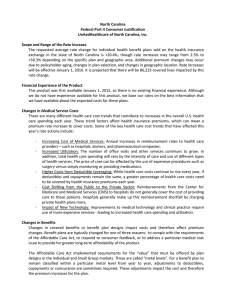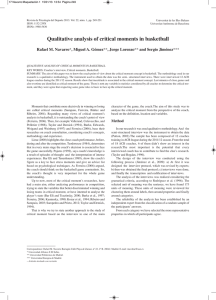100 Years of Gamecock Basketball
Anuncio
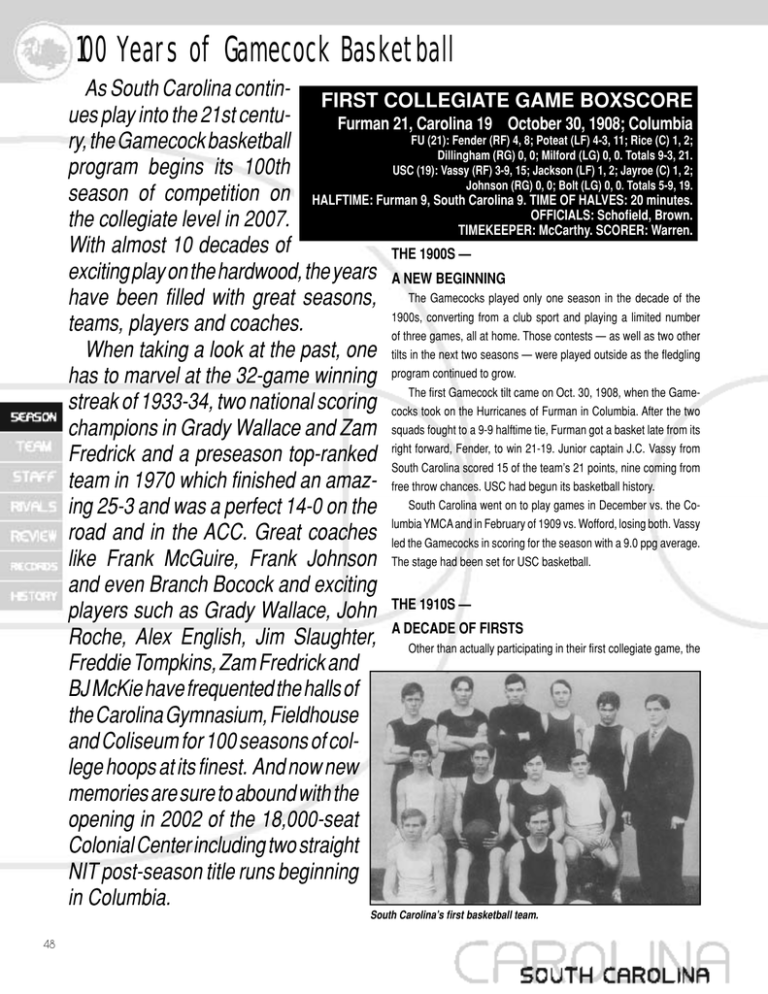
100 Years of Gamecock Basketball As South Carolina contin- FIRST COLLEGIATE GAME BOXSCORE ues play into the 21st centuFurman 21, Carolina 19 October 30, 1908; Columbia FU (21): Fender (RF) 4, 8; Poteat (LF) 4-3, 11; Rice (C) 1, 2; ry, the Gamecock basketball Dillingham (RG) 0, 0; Milford (LG) 0, 0. Totals 9-3, 21. program begins its 100th USC (19): Vassy (RF) 3-9, 15; Jackson (LF) 1, 2; Jayroe (C) 1, 2; (RG) 0, 0; Bolt (LG) 0, 0. Totals 5-9, 19. season of competition on HALFTIME: Furman 9, South Johnson Carolina 9. TIME OF HALVES: 20 minutes. OFFICIALS: Schofield, Brown. the collegiate level in 2007. TIMEKEEPER: McCarthy. SCORER: Warren. With almost 10 decades of THE 1900S — exciting play on the hardwood, the years A NEW BEGINNING have been filled with great seasons, The Gamecocks played only one season in the decade of the 1900s, converting from a club sport and playing a limited number teams, players and coaches. of three games, all at home. Those contests — as well as two other When taking a look at the past, one tilts in the next two seasons — were played outside as the fledgling has to marvel at the 32-game winning program continued to grow. The first Gamecock tilt came on Oct. 30, 1908, when the Gamestreak of 1933-34, two national scoring cocks took on the Hurricanes of Furman in Columbia. After the two champions in Grady Wallace and Zam squads fought to a 9-9 halftime tie, Furman got a basket late from its forward, Fender, to win 21-19. Junior captain J.C. Vassy from Fredrick and a preseason top-ranked right South Carolina scored 15 of the team’s 21 points, nine coming from team in 1970 which finished an amaz- free throw chances. USC had begun its basketball history. ing 25-3 and was a perfect 14-0 on the South Carolina went on to play games in December vs. the Columbia YMCA and in February of 1909 vs. Wofford, losing both. Vassy road and in the ACC. Great coaches led the Gamecocks in scoring for the season with a 9.0 ppg average. like Frank McGuire, Frank Johnson The stage had been set for USC basketball. and even Branch Bocock and exciting players such as Grady Wallace, John THE 1910S — OF FIRSTS Roche, Alex English, Jim Slaughter, A DECADE Other than actually participating in their first collegiate game, the Freddie Tompkins, Zam Fredrick and BJ McKie have frequented the halls of the Carolina Gymnasium, Fieldhouse and Coliseum for 100 seasons of college hoops at its finest. And now new memories are sure to abound with the opening in 2002 of the 18,000-seat Colonial Center including two straight NIT post-season title runs beginning in Columbia. South Carolina’s first basketball team. 48 100 Years of Gamecock Basketball Gamecocks had a decade of firsts in the 1910s. As basketball became more respected in the University and around the state, schedules grew as teams in South Carolina began and continued to field teams. USC played only one game in the 1909-10 season, losing a Nov. 2, 1909 contest at home vs. Davidson, 29-8. Head Coach F.E. Schofield led the Gamecocks in their only documented tilt that season, while senior captain J.H. White and senior Perry Jayroe accounted for all the scoring with six and two points, respectively. A season later, South Carolina notched its first varsity win, downing the Columbia YMCA by a 31-18 count almost 15 months after its previous The 1916-17 Gamecock squad poses for its team photo in front of South Carolina’s first documented game vs. Davidson. Led by freshman basketball home, the Carolina Gymnasium, now known as Longstreet Theater — a theater-in-thecenter J.E. Poole and his 21 points vs. round. the Columbia YMCA, South Carolina THE 1920S — finished the year 1-1, losing to Newberry but setting the foundation for many wins to come. Poole became the first USC player to ever A NEW HOME AND A NEW LEAGUE The 1920s was a decade of growth for the Gamecocks, one that average in double figures for a season with 11.5 points a game. On Jan. 7, 1912, USC officially opened the Carolina Gymnasium would see South Carolina align with a conference and move into one (now Longstreet Theater) for varsity games with USC crushing the of the South’s finest basketball facilities all within a five-year span. The ’20s would also be a time to see head coaches in football and Olympia YMCA, 33-5, in the first game. The Gamecocks’ first collegiate win came at Wofford a week later, which was also USC’s first road basketball as one in the same as Sol Metzger and Branch Bocock victory. Carolina’s first winning season came in the 1913-14 campaign, took their tries on the hardwood and came away with much success. when USC posted a 5-4-1 mark, went a perfect 5-0 at the Gymnasium, Metzger, who coached the 1920-21 Gamecocks, was a respectable 7-11 and 26-18 on the gridiron while Bocock, who had an admirable and had the only tie in school history. The Gamecocks had their share of fine players in the 1910s. mark of 13-7 in two seasons of football coaching, still has one of the R.L. Bowen scored more points than any other USC player in the highest winning percentages in USC basketball history. Bocock was decade while leading the Gamecocks with 9.1 ppg (1914-15), 12.9 33-16 in three seasons (1925-27) for a 67.3% winning tally. In 1922, the Gamecocks got their first taste of conference-like ppg (1915-16) and 11.0 ppg (1916-17) in his first three years. Clark Waring led USC with 12.2 ppg (1917-18) and 14.9 ppg (1918-19) to affiliation by participating in the Southern Intercollegiate Athletic Asclose out the decade while senior captain James Rhea posted the sociation (SIAA) Tournament in Atlanta to end the 1921-22 campaign. highest season point average in the decade, knocking in 15.0 points USC lost to Georgia Tech in the second round but had begun an almost annual season-ending ritual of conference tournaments. The following a tilt in the 1912-13 season. USC had a number of coaches in its first few years of collegiate season, South Carolina joined the Southern Conference — then two ball, but Dixon Foster made his mark on the court, going 26-31 in four years old — and went 0-3 in three SoCon tilts that season. In its final seasons between 1917-20. Foster was also the football head coach SIAA Tournament game in 1923, USC fell to Alabama. A year later, 1924, South Carolina was a full-fledged member of of the Gamecocks for the 1917 and 1919 seasons. the Southern Conference, going 2-2 in the league and losing to Tulane 49 100 Years of Gamecock Basketball in the first round of the tournament in Atlanta. Bocock took over in the 1924-25 season and led the Gamecocks to three-straight winning seasons, including the successful 1926-27 campaign. After 10-7 and 9-5 seasons the previous two years, Bocock and the Gamecocks notched a 14-4 mark in 1927, going 9-1 in the Southern Conference and a perfect 3-0 in one-half season at their new home — the Carolina Fieldhouse. USC began a 42-season affair with the Fieldhouse that year with back-to-back wins over Florida and ended the 1927 campaign with a semifinal loss to Vanderbilt in the conference tourney. A.W. “Rock” Norman began his USC coaching career two years later (1928-29 season), notching a 57-57 record in six seasons overall — the third-longest tenure of any coach in the Gamecock annals. USC wasn’t without its scorers in the decade of the ’20s, though, as forward Thornton Sparkman led the Gamecocks in scoring for three of his four years from 1921-24 and averaged over 10.0 points a game in four seasons. Right behind was center Buster Holcombe, who led Freddie Tompkins 50 the Gamecocks in scoring in 1926-2728 with just under 10.0 points a tilt. THE 1930S — A STRONG SHOWING Led by high scorers, strong coaches and great teams, the Gamecocks of the 1930s posted six-straight winning seasons in the middle of the Coach Billy Laval decade and notching the school’s first conference championship. Under the leadership of Norman, the Gamecocks got off to a slow start with back-to-back 6-10 and 1-17 teams before putting together the most successful back-to-back seasons still in school history. USC dominated Southern Conference play for the 1933-34-35 seasons, led by two of the nation’s top scorers in All-America Freddie Tompkins and Dana Henderson. The string of strong seasons began in 1932-33, just after South Carolina lost at Kentucky to run its record to 2-2. Six weeks later and with 14 wins in a row under their belts, the Gamecocks romped past Duke, 33-21 in the Southern Conference Tournament to post their firstever conference title. Tompkins led USC with 12.7 points a game while Henderson was right behind with 12.1 points a tilt. Football coach Billy Laval took the reigns of the squad for the season, soon to relinquish them back to Norman for the 1933-34 season. USC continued the streak the following season, winning its first 17 games to put the winning tally at 32 straight. After winning 84-9 over Presbyterian to open the 1933-34 campaign, USC posted a perfect, 6-0 mark in the league and seemed headed for another SoCon crown. But a mumps outbreak on the team left both Tompkins and his brother, Bennie, and Henderson in Columbia and N.C. State crushed an outmanned USC team in the first round. With everyone healthy, though, USC defeated Pittsburgh three weeks later, a team considered to be the best in the country. Again, Freddie Tompkins (14.1 ppg) and Henderson (10.6 ppg) led the way. In Norman’s final year at the helm of the Gamecocks, USC could not survive the loss of the Tompkins brothers, but Henderson’s 14.1 100 Years of Gamecock Basketball points a game led the Gamecocks to a 15-9 record. Ending the decade, Ted Petoskey began a five-year career with the USC basketball squad, posting winning seasons in his first two years (1936-1937) before succumbing to losing campaign the next three seasons. THE 1940S — BATTLING THROUGH THE WAR YEARS As Coach Petoskey finished his career in the 1939-40 season with a 5-13 squad, the Gamecocks looked for stability within the system after World War II took many youngsters away to fight. Along came Frank Johnson, who broke the three-year losing skid immediately with a 15-9 record and led the Gamecocks for 14 and one-half seasons, second longest ever in school history. In terms of winning seasons, the 1940s tied with the recentlycompleted 1980s for the second most successful decades in USC hoops lore, notching seven winning campaigns. High scoring became the norm, getting started early with a forward named Preston Westmo- Jim Slaughter reland, who would go on to lead USC in scoring in each of his three seasons (1940-41-42). Also on the scoring front, USC’s first 1,000-Point scorer was born in the decade of the 1940s. Henry Martin, a 5-9 guard from Columbia, led the Gamecocks in scoring in 1943 before the war took him away from playing. Upon his return in 1947, Martin again was among the team scoring leaders for his final three years and finished his career with over 1,000 points for the first time in school history. Due to the war, coaching changes were the norm. After leading USC to a 2-0 mark in the 1942-43 season, Johnson was called to war and football mentor Rex Enright coached the remainder of the campaign for an 11-6 record and 13-6 tally overall. Basketball success at South Carolina did not suffer though, as Lt. Henry Findley (1944) and Johnny McMillan (1945) led the Gamecocks to 13-2 and 19-3 seasons, respectively, before Johnson returned midway through the 1945-46 season. The Gamecocks had two more winning campaigns to finish out the decade, but it was one player who surfaced in the 1940s who would make an impact for many years to come — Jim Slaughter. The first big man for the Gamecocks, the 6-11 Slaughter is the oldest player in USC’s top-five scoring history, notching 1,521 career points. Coach Johnnie McMillan 51 100 Years of Gamecock Basketball THE 1950S — FILLING IT UP Though won-loss records were not the main success story in the 1950s, the high scoring of players like Slaughter and Grady Wallace certainly was. The fun began in the 1949-50 season, Slaughter’s junior year when he became the first USC player to average 20.0 points a game as the Gamecocks notched a 13-9 record. A year later, the Gamecocks were 13-12 but Slaughter upped his scoring tally to 22.8 per game and finished his career at that time as the school’s all-time leading scorer. Dwane Morrison — a junior college transfer who averaged just less than 15 points a game — Joe Smith and Lee Collins filled up the nets for the seasons following Slaughter’s departure with Smith and Collins notching over 1,000 points for their careers. But it was Collins’ 18.2 ppg figure in 1956 that caught the eye of many onlookers — not because he scored 18.2 points a game but because he finished second in the scoring race. Enter Grady Wallace: South Carolina’s all-time two-year scoring leader with over 1,400 points and an average of 28.0 points a game. Coach Frank McGuire Wallace pumped in 23.9 points a tilt for the 9-14 Gamecocks as a junior and led the nation in the 1956-57 season with 31.3 points a game his final campaign. Wallace dominated inside, pulling down 14.4 rebounds a game his senior year. Feeding the ball to Wallace for much of his sophomore season, Ray “Cookie” Pericola made a name for himself after Wallace’s departure, averaging 15.1 points as a junior (1957-58) and 12.8 as a senior (1958-59) to finish with over 1,000 points in his USC career. Scoring points wasn’t all that was on USC Basketballers’ minds in the 1950s — a new conference was. A conference realignment in 1953 created the Atlantic Coast Conference and South Carolina would see action in the competitive league for years to come. In fact, Wallace single-handedly led the 17-12 Gamecocks to back-to-back upsets of Duke and Maryland in the ACC Tournament in 1957, only to lose in the finals to eventual national champion North Carolina and Head Coach Frank McGuire. THE 1960S — USC BEGINS TO EMERGE AS A POWER Grady Wallace 52 After seasons of mediocre play to end the 1950s and into the early 1960s, Gamecock basketball began to flourish under Head Coach Bob 100 Years of Gamecock Basketball 1971 ACC CHAMPIONSHIP TEAM Stevens. Stevens turned around four-straight losing seasons to go 15-12 in 1961-62 and capture ACC Coach of the Year honors. Stevens left after that season and two years later, the same man that led North Carolina over the Gamecocks in the 1957 ACC finals had become the head coach of the Gamecocks — Frank McGuire. It didn’t take long for McGuire to get the pipeline of Northern players working at South Carolina, quickly gaining respect for Gamecock basketball in just three seasons. In 1964, McGuire inherited a USC team short on numbers and finished 6-17. A year later, the Gamecocks turned in an 11-13 season, mainly due to the hard-nosed play of guard Skip Harlicka. In the 196566 season, McGuire returned USC to its winning ways with a 16-7 record and a semifinal berth in the ACC Tournament. Things were changing South of the border. That 16-7 season marked an amazing streak for the GameJohn Roche cocks, mainly under the leadership of McGuire. USC reeled off 15-straight winning seasons, not to have a losing ledger again until the 1981-82 season. Also, wins at Wake Forest, Virginia and Maryland and a home win over North Carolina proved that the Gamecocks were making progress and were looking to the upper tier of the league. Then came along a recruiting class of John Roche, Tom Owens and John Ribock among others; and after Harlicka and the Gamecocks posted a 15-7 record in the 1967-68 season — including a key 87-86 win over North Carolina in Chapel Hill — things looked primed for a spectacular end of the decade. McGuire and the troops did not disappoint the fans as the 1968-69 squad became the first at USC to post 20 wins, going 21-7, winning the Quaker City Classic and advancing into the second round of both the ACC Tournament and the National Invitation Tournament. Led by Roche and Owens — who scored 40.0 points a game between them — the Gamecocks were ready to tackle all comers in the league. In the 1968-69 season, McGuire’s dreams of big-time basketball had come true as the South’s finest basketball arena was finished — the Carolina Coliseum. The 12,401-seat arena would be home to boisterous sell-out crowds for the Gamecocks as the home-court advantage was taken one step further. THE 1970S — USC’S BEST DECADE EVER South Carolina wasted little time getting on track in the decade of the 1970s. In the middle of UCLA’s string of national championships, 53 100 Years of Gamecock Basketball 1973-74 NCAA Tournament Team Front Row (L-R): Tommy Cox, Stu Klitenic, Mike Dunleavy, Nate Davis, Brian Winters, George Felton, Jimmy Walsh. Back Row (L-R): Assistant Coach Don Walsh, Jim Clements, Chuck Sherwood, Alex English, Bob Mathias, Mark Greiner, Jack George, Ed Lynch, Herbert Entzminger, Assistant Coach Ben Jobe, Head Coach Frank McGuire. preseason polls placed the Gamecocks at the No. 1 slot for the 1969-70 season, showing supreme confidence in McGuire and the troops. Unfortunately, USC lost its home opener and was knocked out of the top slot but it was the Gamecocks’ overall dominance of the rugged ACC that was noted. The Gamecocks outscored their opponents by more than 17 points a game and were an uncanny 14-0 on the road, including a sweep of ACC teams en route to a perfect 14-0 record in the league. Disaster struck USC in the ACC Tournament, though, as Roche severely sprained his ankle in a semifinal win and N.C. State pulled out a 1971 ACC Championship trophy 54 double-overtime win in the finals, keeping the Gamecocks out of NCAA Tournament play. USC finished the season with a remarkable 25-3 record. A year later, spurred on by the emergence of sophomore Kevin Joyce, the Gamecocks got revenge. USC finished the season with a 23-6 record and won the Holiday Festival tournament in New York City. But it was Joyce that got a streak rolling. With time running out against North Carolina in the ACC finals and USC down 51-50, a jump ball was called with the 6-3 Joyce and UNC’s 6-10 center Lee Dedmon. Amazingly, Joyce outjumped Dedmon and tipped the ball directly to Owens under the basket for a layup and 52-51 Gamecock victory. South Carolina had won the ACC and was on its way to the first of four-straight NCAA Tournament berths, losing in the Round of 16. After withdrawing from the league, the Gamecocks still had incredible success, going 24-5 in 1971-72, mainly due to the play of Joyce and center Tom Riker, who averaged 19.6 points a game. USC again went to the NCAA Round of 16. The Gamecocks, with a 22-7 record in 1972-73, made the Sweet 16 again and followed the following year with a 22-5 mark and another berth in the big dance. Though the Gamecocks did not make the NCAAs again until the 1988-89 season, a winning record would enhance each of the remaining teams of the 1970s, as well as NIT berths in the 1975 and 1978 seasons. USC honored McGuire and his fine success in his tenure at South Carolina at the end of the 1976-77 season. The playing area of the Carolina Coliseum was donned Frank McGuire Arena. 100 Years of Gamecock Basketball Great players enhanced the fine play of the decade, led by Roche and his three-year scoring record of 1,910 points and an incredible 56-point day vs. Furman his senior season. Alex English came along in 1973 and set the all-time USC scoring mark with 1,972 points in four seasons while teammate Mike Dunleavy notched 1,586 points, also from 1973-76. Other notable greats in the 1970s included Joyce (1,400 points), Riker (1,343), Owens (1,325), Brian Winters (1,079), Mike Doyle (1,360) and Nate Davis (1,345). THE 1980S — A PERIOD OF GROWTH AND RELOADING McGuire coached his final team to begin the decade of the 1980s, leading the Gamecocks to a respectable 16-11 record and ending his career with a 283-142 record. Much of the success of the 1980 squad had to do with Cedrick Hordges, who in two years with USC led the Gamecocks in scoring and had 1,065 points. In McGuire’s last game, a home tilt vs. Western Kentucky, the Gamecocks came back in regulation and pulled off a 73-65 double-overtime win. McGuire was succeeded by Bill Foster, who made himself well known by a national championship appearance with Duke in the 1978 season. Foster didn’t take long to learn the name of Zam Fredrick as Fredrick filled the nets for 28.9 points a game — leading the nation — Zam Fredrick Coach George Felton as USC finished with a 17-10 mark. After their first losing season since 1966, the Gamecocks and Foster rebounded in the 1982-83 season, going 22-9 and advancing to the quarterfinals of the National Invitation Tournament, the first postseason appearance for USC since 1978. A year later, South Carolina would again get into conference action — joining the Metro Conference. Immediately, the Gamecocks got some big wins, including 1985 and 1987 victories over Memphis State, who at the time was ranked in the national Top Five. Foster’s tenure at South Carolina would end in 1986, though, and a member of USC’s last NCAA Tournament team would get the head coaching reigns. George Felton then took over the Gamecock program for the 1986-87 season. Armed with less than 10 scholarship players, Felton and the Gamecocks finished 15-14 in 1986-87 and did something that no other USC squad had accomplished — win a Metro Tournament contest. Terry Dozier had a career-high 38 points and John Breckenridge blocked a last-second Florida State shot as USC made its way for the first time into the Metro semis. After posting a 19-10 record in 1987-88 but failing to go to NCAA play due to probation, USC had more success in 1988-89 than in the previous 15 seasons. The Gamecocks were the first NCAA Tournament team since 1974, were ranked in the nation’s Top 20 for the first time 55 100 Years of Gamecock Basketball 1988-89 NCAA Tournament Team Front Row (L-R): Manager Sherman McEachern, Barry Manning, Eric Sykes, Michael Glover, Jo Jo English, Brent Price, Manager Chris Burgin. Middle Row (L-R): Manager Scott Blair, Graduate Assistant Coach Joe Dooley, Assistant Coach Tubby Smith, Head Coach George Felton, Assistant Coach Eddie Payne, Assistant Coach Scott Rigot, Manager John Turcich. Back Row (L-R): Bill Vernau, Joe Rhett, Sam Rowe, Jeff Roulston, John Breckenridge, John Hudson, Terry Dozier, Troy McKoy. since 1975 and defeated a Top 20 team on the road for the first time since 1975 when USC eliminated a 14-point second-half deficit for a win at Tennessee. The Gamecocks posted highs for Metro record (8-4) and finish (second) and had six wins over NCAA Tournament teams, including Louisville at Frank McGuire Arena. M a n y fine players donned the Garnet & Black in the 1980s, including Terry Dozier, who finished his career with 1,445 career points. Other players who Michael Foster 56 eclipsed the 1,000 point plateau were Jimmy Foster (1,745), Hordges (1,065), Michael Foster (1,192), Fredrick (1,383) and Darryl Martin (1,040). THE 1990S — USC JOINS THE SEC, WINS ITS FIRST TITLE With seemingly all the cards stacked against South Carolina in the 1989-90 season, Felton and the hard-working Gamecocks still pulled out some great wins and finished the campaign at an even 14-14. USC finished the season with only eight scholarship players mainly to injuries but still managed a season-ending win over ACC regular-season champion Clemson at the Frank McGuire Arena. The Gamecocks also posted their finest tournament title since the 1970 Holiday Festival with victories over host UTEP and Kansas State in the El Paso Sun Carnival Classic. In the 1990-91 season, South Carolina began with a bang, winning the championship of the Diet Pepsi Tournament of Champions with impressive upset wins over North Carolina and Houston. The Gamecocks returned home for victories over nationally-ranked Temple and Furman to rank as high as 12th nationally before finishing the season in the NIT. 100 Years of Gamecock Basketball Larry Davis and BJ McKie In quite possibly the biggest moment in Gamecock athletic history, South Carolina began participation in the prestigious Southeastern Conference in the 1991-92 season. Carolina had joined the ranks of Alabama, Auburn, Louisiana State and perennial national power Kentucky six seasons ago and wasn’t looking back ... especially after the incredible finish of the Gamecocks in 1993-94 with an upset of the Wildcats to end the regular season. Then in the 1996-97 season, South Carolina achieved the unthinkable, especially after a less-than-terrific start. South Carolina played its first two months to a 6-5 record that season, but turned around to be the talk of college basketball with a 12-game winning streak. The Gamecocks finished with a 15-1 record and captured the school’s first SEC championship in any sport by completing an unprecedented sweep of Kentucky on Senior Day in Lexington. Though Carolina was upset in the first round of the NCAA Tournament, the Gamecocks revived the spirit of the Frank McGuire Arena with a 24-8 record and a consistent packed house. In the 1990s, seven Gamecocks became members of the 1,000-Point Club. Four joined Alex English, Nate Davis and Henry Martin as native Columbians on the 1,000-point chart: the exciting Jo Jo English (1989-92) posted 1,439 career points at South Carolina, while teammates Barry Manning (1988-92) and Joe Rhett (1989-92) knocked in 1,231 and 1,142 career points, respectively, for the Gamecocks; then nine years later, BJ McKie (1996-99) broke English’s all-time scoring record to end his career with 2,119 points. 1996-97 NCAA Tournament Team and SEC Champions Front Row (L-R): Melvin Watson, Hagen Rouse, Larry Davis, BJ McKie, Antonio Grant. Middle Row (L-R): Manager John Combs, Trainer Jeff Parsons, Assistant Coach Jeff Lebo, Assistant Coach Rick Callahan, Head Coach Eddie Fogler, Assistant Coach John Cooper, Manager Jeff DiBattisto, Manager Drew Jernigan. Back Row (L-R): Herbert Davis, William Gallman, George Formanek, Ryan Stack, Nate Wilbourne, Bud Johnson and Arthur Carlisle. 57 100 Years of Gamecock Basketball 2003-04 NCAA Tournament Team (Front Row): Sheldon Everett, Jeff Vaughn, Josh Gonner, Tarence Kinsey, Jon Land, Mike Boynton, Jr., Tré Kelley, Jarod Gerald, Renaldo Balkman. (Middle Row): Manager Shahryar Humayun, Volunteer Coach Matt Parke, Academic Intern Mark Thompson, Special Assistant Bill Old, Assistant Coach Rick Duckett, Head Coach Dave Odom, Assistant Coach Barry Sanderson, Assistant Coach Ricky Stokes, Volunteer Coach Jeremy Shyatt, Manager Sam Brown, Trainer Dennis Williams. (Back Row): Manager Hall Beard, Ivan Howell, Kerbrell Brown, Rolando Howell, Paulius Joneliunas, John Chappell, Brandon Wallace, Carlos Powell and Strength Coach Darby Rich. Jamie Watson (1991-94) also reached the milestone by finishing with 1,295 career tallies. In 1997, Carolina’s backcourt trio each reached the century mark. Larry Davis (1996-97) finished his twoyear career with 1,068 career points, while Melvin Watson (1995-98) ended with 1,424 points. McKie became the first sophomore in USC history to reach the century mark and is the only player ever to go over the 2,000-point plateau. THE 2000S — A NEW ERA Renaldo Balkman 58 It didn’t take long for a new head coach to make waves at Carolina. In just his first season, 2001-02 Dave Odom led the Gamecocks to the NIT championship game with an impressive postseason run. The Gamecocks advanced to the SEC Tournament semifinals for the fourth time in six years (an SEC best) and won six of their last eight games in the best postseason run in school history. Columbia native Aaron Lucas and Jamel Bradley — who played with hearing aids to overcome an 85 percent hearing loss — became 100 Years of Gamecock Basketball BJ McKie’s jersey was retired in 2005. the first 1,000 point scorers of the new millennium. Individually, Chuck Eidson finished his career with 1,067 points and broke the school record with 272 career steals. Now with the state-of-the-art Colonial Center open, a new set of memories and thrills await Gamecock fans. In 2003-04, USC averaged almost 13,000 fans in The Colonial Center dom helped put USC back on the national map in 2003-04 when USC hosted more than 17,000 fans for the eight-game SEC schedule, including a school record and state of South Carolina-best 18,000 fans for senior night against Kentucky. USC won the Guardians Classic, advanced to the semi-finals of the SEC Tournament and made the NCAA Tournament for the first time in six years. The 2004-05 season included SEC wins over No. 3 Kentucky, Vanderbilt, Ole Miss, Arkansas, Tennessee and the second straight season sweep of Georgia. After falling 53-52 in the SEC Tournament to Ole Miss, after beating the Rebels in overtime to end the regular season just days before, South Carolina took a week off and re-grouped once again. The Gamecocks came out swinging, winning five straight post-season games to capture the 2005 NIT Championship. Carlos Powell, the 2005 NIT MVP, finished his career with 1,541 points - good enough for sixth place on the all-time points list. In 2006, USC won its second straight NIT post-season title, with junior Renaldo Balkman being named the NIT MVP, helping him springboard to the New York Knicks as the 20th pick in the first round. USC defeated eventual NCAA champion Florida twice in the regular season before falling to the Gators 49-47 in the SEC Tournament finals. The NIT Championship win over Michigan was Odom’s 100th win at South Carolina. USC has now won 20 games in four of the last five years under Odom. In 2007 USC saw three players named to the All-SEC teams and Tre’ Kelley won the national award as the top six feet and under point guard - the Frances Pomeroy Naismith Award. Coach Dave Odom Brandon Wallace and Tre’ Kelley 59
